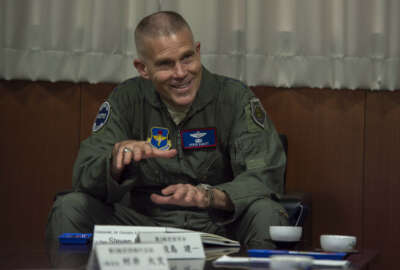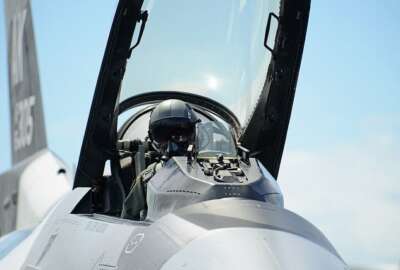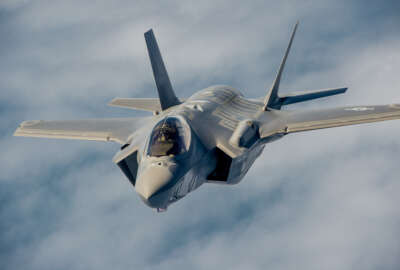
How does the Air Force create a new community for next generation of drone pilots?
Drone pilots in the Air Force are flying Cessnas to learn the basics, but that won't work forever.
Best listening experience is on Chrome, Firefox or Safari. Subscribe to Federal Drive’s daily audio interviews on Apple Podcasts or PodcastOne.
At Beale Air Force Base in Marysville, California, airmen are going up into the air in tiny Cessna planes.
This isn’t some new way to sneak past enemy lines, but rather a temporary option to train the next generation of airmen.
The Air Force is facing quite a dilemma right now when it comes to drone pilots. It has to figure out how to build a drone pilot community and training capabilities without putting its remote pilots through the full course of training it requires for operators of its traditional manned systems.
Drone pilots, without the experience as manned pilots first, “are now lieutenants and captains and within the next couple years you’ll have actual leadership that is purely [drone] pilots,” said. Lt. Col. Bishane “Doc” Whitmore, 12th Reconnaissance Squadron Commander in an interview with Federal News Radio. “The individuals that are coming up now, and the unique skill set of the enlisted [drone] pilots coming up, are going to create a unique cultural shift in the Air Force.”
When drones first started taking off as a viable weapons system, the Air Force temporarily took pilots — at the time, all commissioned officers— from other areas of the service for a few years to fill the demand.
Whitmore said those pilots are now going back to their original specialties and a new culture of drone pilots is emerging. Additionally, the demand for drone pilots is increasing rapidly.
“We have to make sure that we are arming them with the skill sets to be successful as these manned [pilots] go back to their aircraft and we truly are our own community,” he said.
To give these first generation, pure drone pilots the skills they need, the Air Force is using the Squadron Innovation Fund to increase drone pilots’ experience with the Aviation Fundamentals Training program.
The Squadron Innovation Fund is a $64 million kitty spread out among all the squadrons in the service to invest in innovative ideas.
That’s where the Cessna program comes in.
“It’s essentially a flight program that gives them air time to augment [training],” said Maj. Daniel Reed, of the 13th Reconnaissance Squadron Formal Training Unit Command. “Flying in a civilian aircraft focuses on the concept of airmanship, which is a sense that you can only get through experience flying in the air, with an intense focus on situational awareness and communications.”
One of the pilots who has gone through the training, 1st Lt. Miles, whose last name the Air Force requested be withheld to protect the identity of younger pilots, said the Cessna program gave him more confidence in the training he received on the ground.
“I had no background and had zero hours flying when I started training to become an [unmanned aircraft] pilot, and we learned a lot of airmanship,” he said. To go out on the Cessna “and validate the training that I’ve had and see how it fits into the airspace picture in the local area and to see the skills I’ve had as a [drone] pilot, really does apply to the airmanship topic like working the radios, understanding how you fit into airspace, the dos and don’ts are all things that flying this program I’ve been able to see how my training brought me to this point.”
The Cessna program is only a temporary measure though. It offers a cheap and sustainable way for drone pilots to learn, but it’s not necessarily the future.
“We’ve been empowered to solve our problem now, but I don’t know if that’s the solution, long-term, for the remotely piloted aircraft (RPA) community,” said Lt. Col. Carl Maymi, the commander of the 1st Reconnaissance Squadron. “It’s going to be up to Doc Whitmore and Dan Reed to figure that out for the RPA community. There are technologies out there that can probably replace the desired learning objectives we go after by putting [drone] pilots into Cessnas, however, we’re not there yet. You can imagine a virtual environment with some artificial intelligence interface that could create the dynamic environment that you get like flying. But for us right now we don’t have that.”
Maymi said right now Cessnas are a cheap, quick option to solve the problem, but there are better solutions going forward.
The Air Force is already working on some of those options for manned pilots with its Pilot Training Next program.
The program gives pilots their own flight simulators to practice in whenever they want. As the pilots practice, the simulator takes their biometric measures — where their eyes go, what their heart rate is and much more.
The Air Force plans to aggregate that data and use it to help pilots train in the future. Using biometrics to see what flight aspects stress them the most and figuring out how to get a pilot through that hurdle.
The Air Force says it’s working.
“It’s actually amazing what I’ve seen,” said Capt. John Joern, Pilot Training Next instructor, in an interview with Federal News Radio. “A traditional ride in a T-6 for a student in a traditional pilot training base looks like the instructor flying about 95 percent of it, the student maybe flying about 5 percent of it when they are not making gross mistakes. Here, when I took a student up for their very first ride, they’re doing competencies well into the middle of [a traditional] program and they’re flying about 90 percent of the sortie, while I’m just trying to demo the 10 percent.”
It may not be much longer until drone pilots have a similar program or use Pilot Training Next’s equipment and data.
Copyright © 2025 Federal News Network. All rights reserved. This website is not intended for users located within the European Economic Area.
Scott Maucione is a defense reporter for Federal News Network and reports on human capital, workforce and the Defense Department at-large.
Follow @smaucioneWFED






